|
|
 |
Fiche d'espèce de Copépode |
|
|
Calanoida ( Ordre ) |
|
|
|
Clausocalanoidea ( Superfamille ) |
|
|
|
Scolecitrichidae ( Famille ) |
|
|
|
Scolecithricella ( Genre ) |
|
|
| |
Scolecithricella abyssalis (Giesbrecht, 1888) (F, M) | |
| | | | | | | Syn.: | Scolecithrix abyssalis Giesbrecht, 1888; 1892 (p.266, 284, 775, figs.F); Giesbrecht & Schmeil, 1898 (p.43, Rem. F,M); Wolfenden, 1911 (p.250); Sars, 1925 (p.189, figs.F);
Scolecithrix dubia (M) : Giesbrecht, 1892 (p.266, figs.M); Tanaka, 1937 (p.260, figs.M);
? Scolecithrix profunda Giesbrecht, 1892 (p.266);
Scolecithrix tumida T. Scott, 1894 b (p.52, figs.F); Sewell, 1948 (p.523);
no Scolecithricella abyssalis : Tanaka, 1937 (p.260, figs.F, Rem.); ? Rose, 1942 (p.136, figs.F, p. 157, figs.M); Tanaka, 1962 (p.44, M, Rem); Mazza, 1967 (p.168, figs.F, juv.); | | | | Ref.: | | | A. Scott, 1909 (p.89, Rem.F); Rose, 1933 a (p.158, figs.F); Mori, 1937 (1964) (p.52, figs. F); Wilson, 1942 a (p.207, fig.120: F, no fig.132); 1950 (p.331, fig.F); Brodsky, 1950 (1967) (part., p.271, figs.F); ? Marques, 1959 (p.211, figs.F); Grice, 1962 (p.208, figs.F, Rem.); Bradford, 1970 a (p.355, figs.M); Razouls, 1972 (p.94, Annexe: p.56, figs.F); Bradford, 1973 (p.142); Bradford & al.,1983 (p.104, figs.M, Rem.)? Dawson & Knatz, 1980 (p.6, figs.F); Scotto di Carlo & al., 1984 (1043); Campaner, 1984 a (p.182, figs.F, Rem.); Bradford-Grieve & al., 1999 (p.881, 933, figs.F,M); Vyshkvartzeva, 1999 (2000) (p.234); Vives & Shmeleva, 2007 (p.777, figs.F,M, Rem.) | 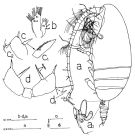 issued from : A.F. Campaner in Bolm. Zool., Univ. S. Paulo, 1984, 6 . [p.183, Fig.9]. Female (off Rio de Janeiro: b, d; Pacific specimen: a, c): a, habitus (lateral left side); a1, genital complex (enlarged); b, Mx1 (Ba2 = basipodal segment 2; Ri = endopodite; Re = exopodite); c, P5; d, P5
|
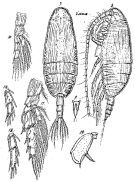 Issued from : G.O. Sars in Résult. Camp. Scient. Prince Albert I, 69, pls.1-127 (1924). [Pl.LII, figs.7-14]. As Scolecithrix abyssalis. Female (from W Mediterranean Sea): 7, habitus (dorsal); 8, idem (lateral left side); 9, rostrum; 10, P1; 11, P2; 12, endopodal segments of P3; 13, endopodal segments of P4; 14, P5. Nota Female: - Rostrum prominent, strongly splitted into 2 narrow points, each bearing a thick and long filament. - Posterolateral corners of the last thoracic segment regularly rounded. - Urosome longer than 1/4 length of prosome. - A1 reaching the end of the caudal rami. - P2 with the spine of the 1st exopodal segment strongly curved inward. - P5 oval lamella-shape, 1 strong spine on the inner margin, 1 little spine at apex, 1 tiny tooth on the external margin.
|
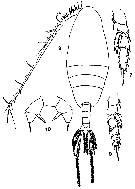 issued from : T. Mori in The pelagic Copepoda from the neighbouring waters of Japan, 1937 (2nd edit., 1964). [Pl.26, Figs.7-10]. Female (E coast of Taiwan): 7, P3 (posterior); 8, habitus (dorsal); 9, P2 (posterior); 10, P5. Nota Female: - Thoracic segments 4 and 5 completely fused. Posterolateral corners of the last thoracic segment rounded. - A1 22-segmented, extend about the caudal rami. - P2 with marginal spine on the 2nd exopodal segment curved. - P5 symmetrical; 1-segmented, its terminal portion somewhat triangulated; there are 3 spines: the outer marginal spine very short, yje inner marginal spine stout and much longer than the terminal one.
|
 issued from : T. Mori in The pelagic Copepoda from the neighbouring waters of Japan, 1937 (2nd edit., 1964). [Pl.25, Fig.13]. Female: 13, P4.
|
 issue from : J.M. Bradford in N. Z. Jl mar. freshw. Res., 1970, 4 (4). [p.355, Figs.26-29]. Male (from Kaikoura): 26, P2; 27, P3; 28, terminal exopod segment of left P5; 29, P5; Scale bars: 0.01 mm (28); 0.1 mm (others)
|
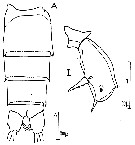 issued from : C. Razouls in Th. Doc. Etat Fac. Sc. Paris VI, 1972, Annexe. [Fig.45, A, I]. Female (from Banyuls, G. of Lion): A, urosome (dorsal); I, P5.
|
 Issued from : W. Giesbrecht in Systematik und Faunistik der Pelagischen Copepoden des Golfes von Neapel und der angrenzenden Meeres-Abschnitte. - Fauna Flora Golf. Neapel, 1892. Atlas von 54 Tafeln. [Taf. 37, Fig. 7 ]. As Scolecithrix abyssalis. Female: 7, habitus (lateral).
|
 Issued from : W. Giesbrecht in Systematik und Faunistik der Pelagischen Copepoden des Golfes von Neapel und der angrenzenden Meeres-Abschnitte. - Fauna Flora Golf. Neapel, 1892. Atlas von 54 Tafeln. [Taf. 13, Fig. 15]. As Scolecithrix abyssalis. Female: 15, P2 (posterior view). B = basipod; St = terminal seta.
|
 Issued from : W. Giesbrecht in Systematik und Faunistik der Pelagischen Copepoden des Golfes von Neapel und der angrenzenden Meeres-Abschnitte. - Fauna Flora Golf. Neapel, 1892. Atlas von 54 Tafeln. [Taf. 13, Fig. 40]. As Scolecithrix abyssalis. Female: P5.
|
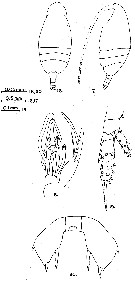 issued from : G.D. Grice in Fish. Bull. Fish and Wildl. Ser., 1962, 61. [p.207, Pl.16, Figs.16-20]. Female (from equatorial Pacific): 16-17, habitus (dorsal and lateral, respectively); 18, terminal part of Mx2; 19, P2; 20, P5. Nota: Some variation was noted in the structure of P5; several specimens did not have the small spine-like protrusion near the terminal spine (fig.20).
|
 Issued from : W. Giesbrecht in Systematik und Faunistik der Pelagischen Copepoden des Golfes von Neapel und der angrenzenden Meeres-Abschnitte. - Fauna Flora Golf. Neapel, 1892. Atlas von 54 Tafeln. [Taf. 13, Fig. 40]. As Scolecithrix abyssalis. Female: 40, P5.
|
 Issued from : W. Giesbrecht in Systematik und Faunistik der Pelagischen Copepoden des Golfes von Neapel und der angrenzenden Meeres-Abschnitte. - Fauna Flora Golf. Neapel, 1892. Atlas von 54 Tafeln. [Taf. 13, Fig. 29]. As Scolecithrix dubia. Male: 29, P5 (anterior view).
|
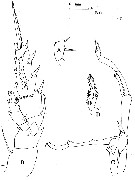 Issued from : J.M. Bradford, L. Haakonssen & J.B. Jillett inNew Zealand Oceanogr. Inst. Memoir 90, 1983. [p.105, Fig.62, A-D]. Female (from off W New Zealand): A; P5. Male (from off NW New Zealand): C, P5; D, terminal part of left leg. Nota Female: - Posterolateral corner of last thoracic segment broadly rounded in lateral view. - Genital segment slightly vaulted ventrally. - A1 21-segmented, reaches almost to caudal rami. - External spine of P2 exopodal segment 1 curved inwards. - P5 semi-oval to triangular; internal spine at mid-length of inner border about twice length of terminal spine; small projection on outer border opposite internal spine.
|
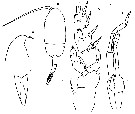 Issued from : O. Tanaka in Japanese J. Zool., 1937, VII, 13. [p.261, Fig.311]. As Scolecithricella dubia. Male (from coast of Heda, Japan): a, habitus (dorsal); b, forehead (lateral); c, rostrum; d, P2; e, P5. Nota Male: - Combined length of the urosome contained 2.6 times in the length of the cephalothorax. - Right A1 19-segmented; segments 8-12, 20-21 and 24-25 fused. Left A1 20-segmented; segments 20 and 21 separated. They reach about to the end of the genital segment. - P5 closely agree with the figure given by Giesbrecht (1892, Taf.13, fig.29). Tanaka (1962) gives for a male from Suruga Bay: Abdomen contained 2.25 times in the length of the cephalothorax. - Abdominal segments and caudal rami in the proportional lengths 15 : 29 : 21 : 21 : 4 : 10 = 100. - A1 extends to the middle of the 2nd abdominal segment - A2 with the exopod 1.4 times as long as endopod.
| | | | | Ref. compl.: | | | Massuti Alzamora, 1942 (p.111); Sewell, 1948 (p.349, 502, 508, 516, 546, 557, 566); Ahlstrom & Thrailkill, 1963 (p.57, Table 5, abundance); Shmeleva, 1964 a (p.1068); Unterüberbacher, 1964 (p.25); Grice & Hulsemann, 1965 (p.224); Mazza, 1966 (p.70); Pavlova, 1966 (p.43); Fleminger, 1967 a (tabl.1); Park, 1970 (p.476); Gamulin, 1971 (p.382, tab.3); Deevey, 1971 (p.224); Björnberg, 1973 (p.332, 389); Vives & al., 1975 (p.43, tab.II, XII); Carter, 1977 (1978) (p.35); Dessier, 1979 (p.205); Pipe & Coombs, 1980 (p.223, figs. 1, 2, table 1, vertical distribution); Vives, 1982 (p.292); Kovalev & Shmeleva, 1982 (p.84); Brenning, 1984 (p.5, Rem.); Guangshan & Honglin, 1984 (p.118, tab.); Brenning, 1985 a (p.28, Table 2); Longhurst, 1985 (tab.2); Rudyakov, 1986 (tab.2); Brinton & al., 1986 (p.228, Table 1); Chen Y.-Q., 1986 (p.205, Table 1: abundance %, Table 2: vertical distribution); Jimenez-Perez & Lara-Lara, 1988; Lozano Soldevilla & al., 1988 (p.59); Gopalakrishnan & Balachandran, 1992 (p.167, figs.1, 4, Table 1, 2); Shih & Young, 1995 (p.73); Gopalakrishnan & Saraledevi, 1998 (p.130, fig.4, chart); Padmavati & al., 1998 (p.347); Hure & Krsinic, 1998 (p.49, 101); Gilabert & Moreno, 1998 (tab.1, 2); Suarez-Morales & Gasca, 1998 a (p.111); Fernandez-Alamo & al., 2000 (p.1139, Appendix); Madhupratap & al., 2001 (p. 1345, vertical distribution vs. O2, figs.4, 5: clusters); Sameoto & al., 2002 (p.13); Vukanic, 2003 (139, tab.1); Lo & al., 2004 (p.89, tab.1); Lavaniegos & Jiménez-Pérez, 2006 (p.155, tab.2, 3, Rem.); Dur & al., 2007 (p.197, Table IV); Ayon & al., 2008 (p.238, Table 4: Peruvian samples); Lan Y.-C. & al., 2009 (p.1, Table 2, % vs hydrogaphic conditions); Mazzocchi & Di Capua, 2010 (p.427); Tutasi & al., 2011 (p.791, Table 2, abundance distribution vs La Niña event); Andersen N.G. & al., 2011 (p.71, Fig.3: abundance); Hidalgo & al., 2012 (p.134, Table 2) ; in CalCOFI regional list (MDO, Nov. 2013; M. Ohman, comm. pers.), Lidvanov & al., 2013 (p.290, Table 2, % composition); Benedetti & al., 2016 (p.159, Table I, fig.1, functional characters); Belmonte, 2018 (p.273, Table I: Italian zones) | | | | NZ: | 19 | | |
|
Carte de distribution de Scolecithricella abyssalis par zones géographiques
|
| | | | | | | | | | | |  issued from : Gopalakrishnan & Saraledevi in Pelagic Biogeography ICoPB II. Proceedings of the 2nd International Conference. Final report of SCOR/IOC working group 93. Noordwijkerhout, The Netherlands 9-14 July 1995. Workshop Report No.142. UNESCO, 1998. [p.131, Fig.4]. issued from : Gopalakrishnan & Saraledevi in Pelagic Biogeography ICoPB II. Proceedings of the 2nd International Conference. Final report of SCOR/IOC working group 93. Noordwijkerhout, The Netherlands 9-14 July 1995. Workshop Report No.142. UNESCO, 1998. [p.131, Fig.4].
Distribution and abundance in number of specimens/standard haul of Scolecithricella abyssalis in the Indian Ocean. |
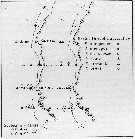 issued from : U. Brenning in Wiss. Z. Wilhelm-Pieck-Univ. Rostock - 33. Jahrgang 1984. Mat.-nat. wiss. Reihe, 6. [p.6, Fig.2]. issued from : U. Brenning in Wiss. Z. Wilhelm-Pieck-Univ. Rostock - 33. Jahrgang 1984. Mat.-nat. wiss. Reihe, 6. [p.6, Fig.2].
Spatial distribution for Scolecithricella abyssalis and other scolecithrids from 8° S - 26° N; 16°- 20° W, for different expeditions (V1: Dec. 1972- Jan. 1973; V2: Feb/Mar. 1973; VI: May 1974; IV: Jun./Jul. 1972). |
| | | | Loc: | | | South Africa (E), Namibia, ? Angola, Congo, G. of Guinea, off SW Ascension Is., Brazil, off Amazon, off Cape Verde Is., Canary Is., off Morocco-Mauritania, off Madeira, Ibero-moroccan Bay, Caribbean Sea, G. of Mexico, Sargasso Sea, off Bermuda, off E Nova Scotia, Medit. (Alboran Sea, Banyuls, NW Basin, Ligurian Sea, Tyrrhenian Sea, Strait of Messina, S Adriatic Sea, Aegean Sea, Lebanon Basin), Arabian Sea, S Madagascar, Natal, SW Indian, Indonesia-Malaysia, Philippines, China Seas (East China Sea, South China Sea), Taiwan Strait, Taiwan, Mienhua Canyon, Japan, Izu region, Bikini, Pacif. (equatorial & NE), Pacif. (W equatorial), New Zealand, California, W BaJa California, Gulf of California, G. of Tehuantepec, off W Guatemala, Galapagos-Ecuador, Peru, Chile (N, off Santiago). Wyville Thomson Ridge (60°N, in Pipe & Coombs, 1980) | | | | N: | 81 | | | | Lg.: | | | (9) F: 2,21-1,74; M: 2,25-1,45; (47) F: 1,9; (101) F: 2,21-1,74; (117) M: 1,45; (128) M: 1,48; (432) F: 2,15-1,7; (1111) F: 1,73-2,06; {F: 1,70-2,21; M: 1,45-2,25} | | | | Rem.: | épi-mésopélagique.
Pour Campaner (1984 a) les mâles décrits par Rose (1942) et Tanaka (1962) n’appartiennent pas à cette espèce, mais à S. vittata dans le premier cas, et n’est pas attribué dans le second.
Un doute subsiste sur l'identité entre cette espèce et S. profunda.
Voir aussi les remarques en anglais | | | Dernière mise à jour : 18/01/2021 | |
|
|
 Toute utilisation de ce site pour une publication sera mentionnée avec la référence suivante : Toute utilisation de ce site pour une publication sera mentionnée avec la référence suivante :
Razouls C., Desreumaux N., Kouwenberg J. et de Bovée F., 2005-2025. - Biodiversité des Copépodes planctoniques marins (morphologie, répartition géographique et données biologiques). Sorbonne Université, CNRS. Disponible sur http://copepodes.obs-banyuls.fr [Accédé le 03 décembre 2025] © copyright 2005-2025 Sorbonne Université, CNRS
|
|
 |
 |



















